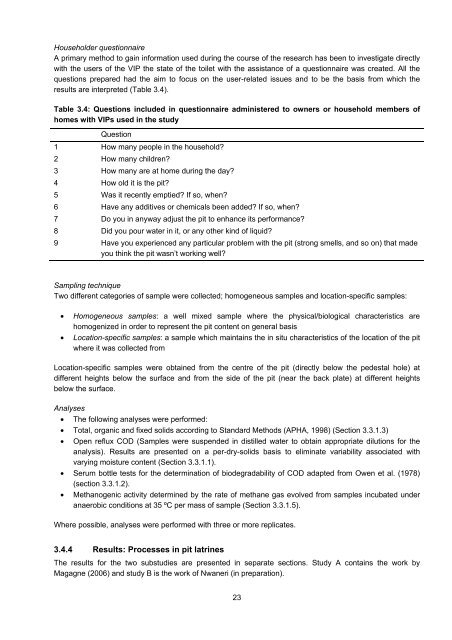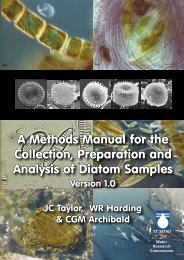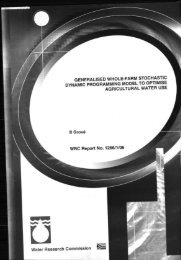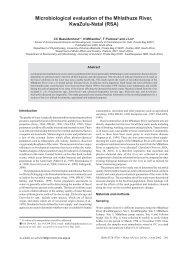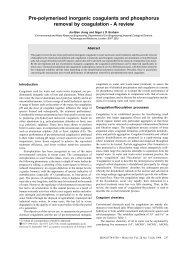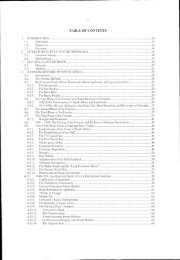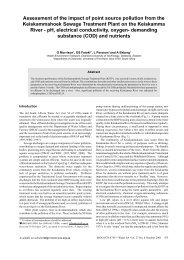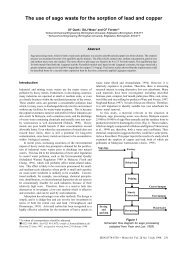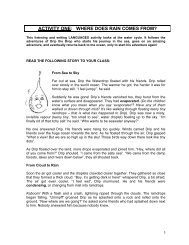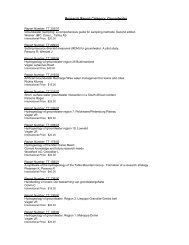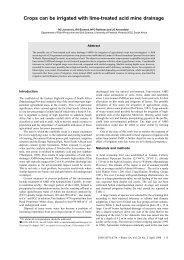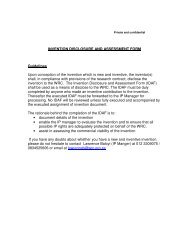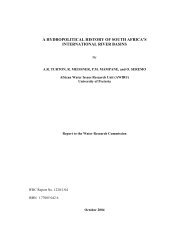and the Efficacy of Pit Latrine Additives - Water Research Commission
and the Efficacy of Pit Latrine Additives - Water Research Commission
and the Efficacy of Pit Latrine Additives - Water Research Commission
- No tags were found...
Create successful ePaper yourself
Turn your PDF publications into a flip-book with our unique Google optimized e-Paper software.
Householder questionnaire<br />
A primary method to gain information used during <strong>the</strong> course <strong>of</strong> <strong>the</strong> research has been to investigate directly<br />
with <strong>the</strong> users <strong>of</strong> <strong>the</strong> VIP <strong>the</strong> state <strong>of</strong> <strong>the</strong> toilet with <strong>the</strong> assistance <strong>of</strong> a questionnaire was created. All <strong>the</strong><br />
questions prepared had <strong>the</strong> aim to focus on <strong>the</strong> user-related issues <strong>and</strong> to be <strong>the</strong> basis from which <strong>the</strong><br />
results are interpreted (Table 3.4).<br />
Table 3.4: Questions included in questionnaire administered to owners or household members <strong>of</strong><br />
homes with VIPs used in <strong>the</strong> study<br />
Question<br />
1 How many people in <strong>the</strong> household<br />
2 How many children<br />
3 How many are at home during <strong>the</strong> day<br />
4 How old it is <strong>the</strong> pit<br />
5 Was it recently emptied If so, when<br />
6 Have any additives or chemicals been added If so, when<br />
7 Do you in anyway adjust <strong>the</strong> pit to enhance its performance<br />
8 Did you pour water in it, or any o<strong>the</strong>r kind <strong>of</strong> liquid<br />
9 Have you experienced any particular problem with <strong>the</strong> pit (strong smells, <strong>and</strong> so on) that made<br />
you think <strong>the</strong> pit wasn’t working well<br />
Sampling technique<br />
Two different categories <strong>of</strong> sample were collected; homogeneous samples <strong>and</strong> location-specific samples:<br />
<br />
<br />
Homogeneous samples: a well mixed sample where <strong>the</strong> physical/biological characteristics are<br />
homogenized in order to represent <strong>the</strong> pit content on general basis<br />
Location-specific samples: a sample which maintains <strong>the</strong> in situ characteristics <strong>of</strong> <strong>the</strong> location <strong>of</strong> <strong>the</strong> pit<br />
where it was collected from<br />
Location-specific samples were obtained from <strong>the</strong> centre <strong>of</strong> <strong>the</strong> pit (directly below <strong>the</strong> pedestal hole) at<br />
different heights below <strong>the</strong> surface <strong>and</strong> from <strong>the</strong> side <strong>of</strong> <strong>the</strong> pit (near <strong>the</strong> back plate) at different heights<br />
below <strong>the</strong> surface.<br />
Analyses<br />
The following analyses were performed:<br />
Total, organic <strong>and</strong> fixed solids according to St<strong>and</strong>ard Methods (APHA, 1998) (Section 3.3.1.3)<br />
Open reflux COD (Samples were suspended in distilled water to obtain appropriate dilutions for <strong>the</strong><br />
analysis). Results are presented on a per-dry-solids basis to eliminate variability associated with<br />
varying moisture content (Section 3.3.1.1).<br />
Serum bottle tests for <strong>the</strong> determination <strong>of</strong> biodegradability <strong>of</strong> COD adapted from Owen et al. (1978)<br />
(section 3.3.1.2).<br />
Methanogenic activity determined by <strong>the</strong> rate <strong>of</strong> methane gas evolved from samples incubated under<br />
anaerobic conditions at 35 ºC per mass <strong>of</strong> sample (Section 3.3.1.5).<br />
Where possible, analyses were performed with three or more replicates.<br />
3.4.4 Results: Processes in pit latrines<br />
The results for <strong>the</strong> two substudies are presented in separate sections. Study A contains <strong>the</strong> work by<br />
Magagne (2006) <strong>and</strong> study B is <strong>the</strong> work <strong>of</strong> Nwaneri (in preparation).<br />
23


